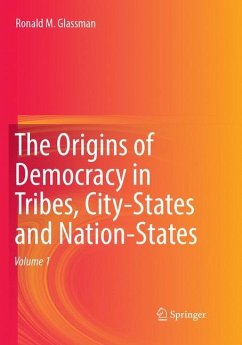Ronald M. Glassman
The Origins of Democracy in Tribes, City-States and Nation-States
Ronald M. Glassman
The Origins of Democracy in Tribes, City-States and Nation-States
- Broschiertes Buch
- Merkliste
- Auf die Merkliste
- Bewerten Bewerten
- Teilen
- Produkt teilen
- Produkterinnerung
- Produkterinnerung
This four-part work describes and analyses democracy and despotism in tribes, city-states, and nation states. The theoretical framework used in this work combines Weberian, Aristotelian, evolutionary anthropological, and feminist theories in a comparative-historical context. The dual nature of humans, as both an animal and a consciously aware being, underpins the analysis presented.
Part One covers tribes. It uses anthropological literature to describe the "campfire democracy" of the African Bushmen, the Pygmies, and other band societies. Its main focus is on the tribal democracy of the…mehr
Andere Kunden interessierten sich auch für
![Bichitra: The Making of an Online Tagore Variorum Bichitra: The Making of an Online Tagore Variorum]() Bichitra: The Making of an Online Tagore Variorum38,99 €
Bichitra: The Making of an Online Tagore Variorum38,99 €![Reviving Aleppo Reviving Aleppo]() Reviving Aleppo104,99 €
Reviving Aleppo104,99 €![Social mobility in the elite. To what extent does the probability of attaining elite positions depend on elite origins? Social mobility in the elite. To what extent does the probability of attaining elite positions depend on elite origins?]() Sebastian SteidleSocial mobility in the elite. To what extent does the probability of attaining elite positions depend on elite origins?15,95 €
Sebastian SteidleSocial mobility in the elite. To what extent does the probability of attaining elite positions depend on elite origins?15,95 €![Origins of the Urban School Origins of the Urban School]() Marvin LazersonOrigins of the Urban School60,00 €
Marvin LazersonOrigins of the Urban School60,00 €![The Origins and Continuity of Chinese Sociology The Origins and Continuity of Chinese Sociology]() Tiankui JingThe Origins and Continuity of Chinese Sociology104,99 €
Tiankui JingThe Origins and Continuity of Chinese Sociology104,99 €![The Future of Democracy The Future of Democracy]() Ronald M. GlassmanThe Future of Democracy45,99 €
Ronald M. GlassmanThe Future of Democracy45,99 €![The Future of Democracy The Future of Democracy]() Ronald M. GlassmanThe Future of Democracy60,99 €
Ronald M. GlassmanThe Future of Democracy60,99 €-
-
-
This four-part work describes and analyses democracy and despotism in tribes, city-states, and nation states. The theoretical framework used in this work combines Weberian, Aristotelian, evolutionary anthropological, and feminist theories in a comparative-historical context. The dual nature of humans, as both an animal and a consciously aware being, underpins the analysis presented.
Part One covers tribes. It uses anthropological literature to describe the "campfire democracy" of the African Bushmen, the Pygmies, and other band societies. Its main focus is on the tribal democracy of the Cheyenne, Iroquois, Huron, and other tribes, and it pays special attention to the role of women in tribal democracies. Part Two describes the city-states of Mesopotamia, Syria, and Canaan-Phoenicia, and includes a section on the theocracy of the Jews. This part focuses on the transition from tribal democracy to city-state democracy in the ancient Middle East - from the Sumerian city-statesto the Phoenician. Part Three focuses on the origins of democracy and covers Greece-Mycenaean, Dorian, and the Golden Age. It presents a detailed description of the tribal democracy of Archaic Greece - emphasizing the causal effect of the hoplite-phalanx military formation in egalitarianizing Greek tribal society. Next, it analyses the transition from tribal to city-state democracy-with the new commercial classes engendering the oligarchic and democratic conflicts described by Plato and Aristotle. Part Four describes the Norse tribes as they contacted Rome, the rise of kingships, the renaissance of the city-states, and the parliamentary monarchies of the emerging nation-states. It provides details of the rise of commercial city states in Renaissance Italy, Hanseatic Germany and the Netherlands.
Hinweis: Dieser Artikel kann nur an eine deutsche Lieferadresse ausgeliefert werden.
Part One covers tribes. It uses anthropological literature to describe the "campfire democracy" of the African Bushmen, the Pygmies, and other band societies. Its main focus is on the tribal democracy of the Cheyenne, Iroquois, Huron, and other tribes, and it pays special attention to the role of women in tribal democracies. Part Two describes the city-states of Mesopotamia, Syria, and Canaan-Phoenicia, and includes a section on the theocracy of the Jews. This part focuses on the transition from tribal democracy to city-state democracy in the ancient Middle East - from the Sumerian city-statesto the Phoenician. Part Three focuses on the origins of democracy and covers Greece-Mycenaean, Dorian, and the Golden Age. It presents a detailed description of the tribal democracy of Archaic Greece - emphasizing the causal effect of the hoplite-phalanx military formation in egalitarianizing Greek tribal society. Next, it analyses the transition from tribal to city-state democracy-with the new commercial classes engendering the oligarchic and democratic conflicts described by Plato and Aristotle. Part Four describes the Norse tribes as they contacted Rome, the rise of kingships, the renaissance of the city-states, and the parliamentary monarchies of the emerging nation-states. It provides details of the rise of commercial city states in Renaissance Italy, Hanseatic Germany and the Netherlands.
Hinweis: Dieser Artikel kann nur an eine deutsche Lieferadresse ausgeliefert werden.
Produktdetails
- Produktdetails
- Verlag: Springer / Springer International Publishing / Springer, Berlin
- Artikelnr. des Verlages: 978-3-319-84718-4
- Softcover reprint of the original 1st ed. 2017
- Seitenzahl: 1928
- Erscheinungstermin: 6. September 2018
- Englisch
- Abmessung: 254mm x 178mm x 103mm
- Gewicht: 3541g
- ISBN-13: 9783319847184
- ISBN-10: 331984718X
- Artikelnr.: 55127679
- Herstellerkennzeichnung Die Herstellerinformationen sind derzeit nicht verfügbar.
- Verlag: Springer / Springer International Publishing / Springer, Berlin
- Artikelnr. des Verlages: 978-3-319-84718-4
- Softcover reprint of the original 1st ed. 2017
- Seitenzahl: 1928
- Erscheinungstermin: 6. September 2018
- Englisch
- Abmessung: 254mm x 178mm x 103mm
- Gewicht: 3541g
- ISBN-13: 9783319847184
- ISBN-10: 331984718X
- Artikelnr.: 55127679
- Herstellerkennzeichnung Die Herstellerinformationen sind derzeit nicht verfügbar.
Ronald Glassman is a sociology professor at New York University located in New York, New York.
Part I. The Emergence of Democracy in Bands and Tribes.- Chapter 1. Civilizations Peculiarities and Ideal Typicalities.- Chapter 3. Social Structure and Conflict Groups.- Chapter 4. Legitimation Process.- Chapter 5. Economy and Polity.- Chapter 6. Warfare and Religion.- Chapter 7. Chapter 7. Civilizational Peculiarities vs. Ideal Typicalities.- Chapter 8. Social Structure and Conflict Groups.- Chapter 9. The Political Institutions of Tribal societies: Kinship Democracy.- Chapter 10. Horticulture, Matri-Clans, and the Rise of the Status and Power of Women.- Chapter 11. Warfare and Politics.- Chapter 12. The Confederacy of Tribes: Representative Democracy Extended.- Chapter 13. Tribal Games.- Chapter 14. Religion and Politics in Tribal Society.- Chapter 15. Legitimation Processes in Tribal Society.- Chapter 16. Economy and Polity.- Chapter 17. Conclusions on Band and Tribal Societies.- Chapter 18. Civilization Peculiarities vs. Ideal Typicalities.- Chapter 19. Social Structure and Conflict Groups.- Chapter 20. Religion and Politics.- Chapter 21. Women and Politics in Horticultural Societies.- Chapter 22. Warfare in Horticultural Village Societies.- Chapter 23. Political Institutions: Theocratic Despotism.- Chapter 24. Legitimation Processes.- Chapter 25. Civilizational Peculiarities vs. Ideal Typicalities.- Chapter 26. Herding Tribes, Patri-Clans, and the Ride of the Military Kingship.- Chapter 27. Social Structure and Conflict Groups.- Chapter 28. Warfare, Women, Religion and Politics.- Chapter 29. The Political Institutions of Herding Society: Despotic Military Kingship.- Chapter 30. Military Kingship and State Violence.- Chapter 31. The Legitimacy Processes of Herding Societies.- Chapter 32. Economy and Polity.- Chapter 33. Some Impediments to Democracy in Horticultural and Herding Societies.- Chapter 34. Conclusions: The Paradox of Tribes.- Chapter 35. Introduction to the Middle Eastern Grain, Agricultural, and Animal Herding Societies.- Chapter 36. Democracy in the Sumerian City-States: The Assembly, the Elders, and the King.- Chapter 37. Projections of the Tribal Assembly in the World of the Sumerian Myths.- Chapter 38. The Status and Role of women in Ancient Sumer.- Chapter 39. The Temple Economy overseen by Priests and Priestesses.- Chapter 40. The Rise of the Kingship-Expansionary, Genocidal Warfare.- Chapter 41. From the Theocratic State to the Kingly-Bureaucratic State.- Chapter 42. The Reform Movements, the Ethic of Social Justice, and the Great Law Codes.- Chapter 43. The Pastoral Tribal Invasions and the Partial De-legitimation of the Kingship.- Chapter 44. The Expansion of the Merchant-Artisan Trading Sector of the Economy with the revival of Tribal Democracy and the Rise of Merchant Oligarchy.-Chapter 45. The Early Agricultural City-States of Canaan, Lebanon, and Syria.- Chapter 46. Ugarit-A Great Coastal Trading City.- Chapter 47. West Semitic Myths: The Ras Shamra Texts of Ugarit.- Chapter 48. Ebla-A Great Caravan City.-Chapter 49. The Political Structure of the Canaanite City-States: Monarchy and Merchant Oligarchy.- Chapter 50. From Canaanites to Phoenicians: A Tumultuous History of Conquest,Resistance, and Change.- Chapter 51. The Political Institutions of the Phoenician City-States: Merchant Oligarchy with Remnants of Democracy in the Assembly of All the Citizens.- Chapter 52. The Political Institutions of Carthage: A Perfect Example of Aristotle's Mixed Polity (with elements of Monarchy, Oligarchy, and Democracy).- Chapter 53. Religion and Women in Phoenician Society: The Fertility Cult, Death and Resurrection, the High Priestesses, and the High Status of Women.- Chapter 54. The Pastoral Origins of the Jews.- Chapter 55. Egyptian History and the Hebrews.- Chapter 56. Egypt after the Hyksos Expulsion.- Chapter 57. The Supreme Deity in the New Egyptian Theology.- Chapter 58. The Hebrews in the Nile Delta.- Chapter 59. From Joseph to Moses: Biblical Myth and History.- Chapter 60. The Israelite Tribal confederation Enters Canaan.- Chapter 61. Rise of the Israelite King.- Chapter 62. The Prophets Reassert the. Religion of Moses.- Chapter 63. The Babylonian Exile.- Chapter 64. The Return from Exile: Theoracy Established.- Chapter 65. Monotheism and the Jews.- Chapter 66. The Status of Women under Monotheism.- Part III. Greece.- Chapter 67. Minoan and Mycenaean Civilizations.- Chapter 68. The Expansion of Mycenaean Civilization.- Chapter 69. The Doric Invasions and the Regression to Tribalism.- Chapter 70. Doric Tribalism and the Culture of Greece.- Chapter 71. Doric Religion.- Chapter 72. The Olympic Games: Doric Tribal Culture engenders a Pan-Hellenic Cultural Complex.- Chapter 73. From Aristocratic Champions to the Phalanx of the Common Men.- Chapter 74. The Cavalry Aristocrats: "Hippeis" and Their Declining Role.- Chapter 75. Sparta.- Chapter 76. The Spartan Women: Economic Control, Sexual Liberation, Olympic-Style Athletics.- Chapter 77. Some Notes on the Democratization of Argos and Crete.- Chapter 78. The Political Paradox in the Transition from the Tribe to the City-State in Greece.- Chapter 79. The Revival of Trade in the Aegean Region.- Chapter 80. Trade and the Changing Class Structure of Greece.- Chapter 81. The Rise of the Greek Trading Cities.- Chapter 82. The Transition from Tribal to City-State Political Organization in Greece.- Chapter 83. The Rise of Democracy in Syracuse.- Chapter 84. Class Conflicts in the City-States During the Era of Expansionary Trade.- Chapter 85. Conclusions on the Causes of Democracy in Greece.- Chapter 86. The Ideology of Equality and Democracy.- Chapter 87. The Rise of Legal-Authority.- Chapter 88. The Ionians of Asia Minor make Contact with the Civilizations of the Middle East and Egypt, and the Tribes of the Black Sea Region.- Chapter 89. The Decline of Greek Religion After Homer and Hesiod.- Chapter 90. The Rise of the Rational-Scientific World View.- Chapter 91. The Rise of the Social Sciences.-Chapter 92. Doric Women.- Chapter 93. Ionian Woman.- Chapter 94. The Women Philosophers, Scientists, Doctors, and Mathematicians of the Greek World.- Chapter 95. Women and Religion.- Part IV. The Norse Tribes: From Tribal Democracy and Aristocracy to City-State Democracy and the Kingly-Bureaucratic State.- Chapter 96. Comparison between the German Tribes and the Celtic Tribes.- Chapter 97. The Germanoi or Norse Tribes.- Chapter 98: The Economy of the Norse Tribes: Herding and Agriculture.- Chapter 99. The Religion of the Norse Tribes: No Official Priesthood.- Chapter 100. Marriage, Clans, and Clan Retribution.- Chapter 101. Language and Runes.- Chapter 102. Debt Slavery and War Captives.- Chapter 103. Civilizational Influences.- Chapter 104. Feasts, Celebrations, and Guest Friendships.- Chapter 105. Norse Tribal Assemblies. Courts, and the Rise of the Monarchies.- Chapter 106. The Political Structure of the Norse Tribes: The Assembly of Warriors with Aristocratic Domination.- Chapter 107. A Closer Look at the Norse Assemblies.- Chapter 108. War Chiefs and the Military Aristocrats.- Chapter 109. Iceland: Nobles and Free Men Flee the Norwegian Kingship and Re¬establish Tribal Democracy (with Aristocratic Domination').- Chapter 110. The Anglo-Saxon-Jute Tribal Confederation and its Moot and Folkmoot.- Chapter 111. The Court Councils of the Centralizing Monarchies.- Chapter 112. Creation of the World and the Gods.- Chapter 113. The Class Structure of the Norse Tribes as Shown in "The Song of RY''.- Chapter 114. Women in the Myths and Sagas.- Chapter 115. Games and Individual Competitions.- Chapter 116. Magic and Runes.- Chapter 117. The Volsung Saga.- Chapter 118. Beowulf.- Chapter 119. The Icelandic Sagas.- Chapter 120. The Netherlands.- Chapter 121. The Norse Tribes in the High Mountains Valleys of Switzerland.- Chapter 122. The Celtic Gauls and the Romans.- Chapter 123. The Invasion of the Norse Tribes.- Chapter 124. The Importance of City-States in the Evolution of Democratic Political Processes.- Chapter 125. The Transitions from Tribal Democracy to City-State Democracy in Italy.- Chapter 126. The Germanic City-States.- Chapter 127. The Cities of the Low Countries.- Chapter 128. The Trade- Capitalist city-states of Switzerland.- Chapter 129. The German Trade - Capitalist City- States.- Chapter 130. German Kings against the Pope and the Italian- dominated Church.- Chapter 131. A Weber-Marx Synthesis: Trade-Capitalist city-states and the Reformation.- Chapter 132. The Centralizing Monarchies Become Dependent on Money from the City-States.- Chapter 133. The Swiss Confederation.- Chapter 134. The Parliament in the Netherlands: The States General.- Chapter 135. The Romanized Celtic Colony of Britain.- Chapter 136. The Invasion of Romanized Britain by the Anglo-Saxon-Jute Confederation.- Chapter 137. The Second Danish Invasion and the Norman Invasion: King Canute and William the Conqueror.- Chapter 138. The Commercial Trade-Capitalist Economy in Britain: the Rise of the Merchant Gentry.- Chapter 139. The Rise of the English Parliament.- Chapter 140. The Reformation in England and Scotland: Before Luther and Calvin.- Chapter 141. The Beginnings of the English Civil War.- Chapter 142. The English Revolution-"Civil War"-"Puritan Revolt".- Chapter 143. With Monarchy and Feudalism defeated, the Struggle between the Rich, the Poor, and the Middle Classes Takes Center Stage.- Chapter 144. Rational Legal Authority in England.- Chapter 145. The Rise of the Rational-Scientific worldview in Britain.- Chapter 146. The United States: The English Revolution Continues.- Chapter 147. France: The Stalemate of Classes: Anarchic and Anomic Violence.- Chapter 148. Germany: Feudalism. Kingship and the Warrior Cynosure remain Culturally Dominant.- Chapter 149. Spain: The Conquest of the Moslems and the New World Empires Enriches the Monarchy and Weakens the Commercial classes.- Chapter 150. Conclusions on the Rise of Commercial Capitalism. Parliamentary Democracy and the Decline of Feudalism.- Chapter 151. From Trade-Capitalism to Industrial Capitalism.- Chapter 152. The Class Structure of Industrial Capitalism.- Chapter 153. Women's Gender Roles: From Horticulture to Modern Technocratic "White Collar" Work.- Epilogue.
Part I. The Emergence of Democracy in Bands and Tribes.- Chapter 1. Civilizations Peculiarities and Ideal Typicalities.- Chapter 3. Social Structure and Conflict Groups.- Chapter 4. Legitimation Process.- Chapter 5. Economy and Polity.- Chapter 6. Warfare and Religion.- Chapter 7. Chapter 7. Civilizational Peculiarities vs. Ideal Typicalities.- Chapter 8. Social Structure and Conflict Groups.- Chapter 9. The Political Institutions of Tribal societies: Kinship Democracy.- Chapter 10. Horticulture, Matri-Clans, and the Rise of the Status and Power of Women.- Chapter 11. Warfare and Politics.- Chapter 12. The Confederacy of Tribes: Representative Democracy Extended.- Chapter 13. Tribal Games.- Chapter 14. Religion and Politics in Tribal Society.- Chapter 15. Legitimation Processes in Tribal Society.- Chapter 16. Economy and Polity.- Chapter 17. Conclusions on Band and Tribal Societies.- Chapter 18. Civilization Peculiarities vs. Ideal Typicalities.- Chapter 19. Social Structure and Conflict Groups.- Chapter 20. Religion and Politics.- Chapter 21. Women and Politics in Horticultural Societies.- Chapter 22. Warfare in Horticultural Village Societies.- Chapter 23. Political Institutions: Theocratic Despotism.- Chapter 24. Legitimation Processes.- Chapter 25. Civilizational Peculiarities vs. Ideal Typicalities.- Chapter 26. Herding Tribes, Patri-Clans, and the Ride of the Military Kingship.- Chapter 27. Social Structure and Conflict Groups.- Chapter 28. Warfare, Women, Religion and Politics.- Chapter 29. The Political Institutions of Herding Society: Despotic Military Kingship.- Chapter 30. Military Kingship and State Violence.- Chapter 31. The Legitimacy Processes of Herding Societies.- Chapter 32. Economy and Polity.- Chapter 33. Some Impediments to Democracy in Horticultural and Herding Societies.- Chapter 34. Conclusions: The Paradox of Tribes.- Chapter 35. Introduction to the Middle Eastern Grain, Agricultural, and Animal Herding Societies.- Chapter 36. Democracy in the Sumerian City-States: The Assembly, the Elders, and the King.- Chapter 37. Projections of the Tribal Assembly in the World of the Sumerian Myths.- Chapter 38. The Status and Role of women in Ancient Sumer.- Chapter 39. The Temple Economy overseen by Priests and Priestesses.- Chapter 40. The Rise of the Kingship-Expansionary, Genocidal Warfare.- Chapter 41. From the Theocratic State to the Kingly-Bureaucratic State.- Chapter 42. The Reform Movements, the Ethic of Social Justice, and the Great Law Codes.- Chapter 43. The Pastoral Tribal Invasions and the Partial De-legitimation of the Kingship.- Chapter 44. The Expansion of the Merchant-Artisan Trading Sector of the Economy with the revival of Tribal Democracy and the Rise of Merchant Oligarchy.-Chapter 45. The Early Agricultural City-States of Canaan, Lebanon, and Syria.- Chapter 46. Ugarit-A Great Coastal Trading City.- Chapter 47. West Semitic Myths: The Ras Shamra Texts of Ugarit.- Chapter 48. Ebla-A Great Caravan City.-Chapter 49. The Political Structure of the Canaanite City-States: Monarchy and Merchant Oligarchy.- Chapter 50. From Canaanites to Phoenicians: A Tumultuous History of Conquest,Resistance, and Change.- Chapter 51. The Political Institutions of the Phoenician City-States: Merchant Oligarchy with Remnants of Democracy in the Assembly of All the Citizens.- Chapter 52. The Political Institutions of Carthage: A Perfect Example of Aristotle's Mixed Polity (with elements of Monarchy, Oligarchy, and Democracy).- Chapter 53. Religion and Women in Phoenician Society: The Fertility Cult, Death and Resurrection, the High Priestesses, and the High Status of Women.- Chapter 54. The Pastoral Origins of the Jews.- Chapter 55. Egyptian History and the Hebrews.- Chapter 56. Egypt after the Hyksos Expulsion.- Chapter 57. The Supreme Deity in the New Egyptian Theology.- Chapter 58. The Hebrews in the Nile Delta.- Chapter 59. From Joseph to Moses: Biblical Myth and History.- Chapter 60. The Israelite Tribal confederation Enters Canaan.- Chapter 61. Rise of the Israelite King.- Chapter 62. The Prophets Reassert the. Religion of Moses.- Chapter 63. The Babylonian Exile.- Chapter 64. The Return from Exile: Theoracy Established.- Chapter 65. Monotheism and the Jews.- Chapter 66. The Status of Women under Monotheism.- Part III. Greece.- Chapter 67. Minoan and Mycenaean Civilizations.- Chapter 68. The Expansion of Mycenaean Civilization.- Chapter 69. The Doric Invasions and the Regression to Tribalism.- Chapter 70. Doric Tribalism and the Culture of Greece.- Chapter 71. Doric Religion.- Chapter 72. The Olympic Games: Doric Tribal Culture engenders a Pan-Hellenic Cultural Complex.- Chapter 73. From Aristocratic Champions to the Phalanx of the Common Men.- Chapter 74. The Cavalry Aristocrats: "Hippeis" and Their Declining Role.- Chapter 75. Sparta.- Chapter 76. The Spartan Women: Economic Control, Sexual Liberation, Olympic-Style Athletics.- Chapter 77. Some Notes on the Democratization of Argos and Crete.- Chapter 78. The Political Paradox in the Transition from the Tribe to the City-State in Greece.- Chapter 79. The Revival of Trade in the Aegean Region.- Chapter 80. Trade and the Changing Class Structure of Greece.- Chapter 81. The Rise of the Greek Trading Cities.- Chapter 82. The Transition from Tribal to City-State Political Organization in Greece.- Chapter 83. The Rise of Democracy in Syracuse.- Chapter 84. Class Conflicts in the City-States During the Era of Expansionary Trade.- Chapter 85. Conclusions on the Causes of Democracy in Greece.- Chapter 86. The Ideology of Equality and Democracy.- Chapter 87. The Rise of Legal-Authority.- Chapter 88. The Ionians of Asia Minor make Contact with the Civilizations of the Middle East and Egypt, and the Tribes of the Black Sea Region.- Chapter 89. The Decline of Greek Religion After Homer and Hesiod.- Chapter 90. The Rise of the Rational-Scientific World View.- Chapter 91. The Rise of the Social Sciences.-Chapter 92. Doric Women.- Chapter 93. Ionian Woman.- Chapter 94. The Women Philosophers, Scientists, Doctors, and Mathematicians of the Greek World.- Chapter 95. Women and Religion.- Part IV. The Norse Tribes: From Tribal Democracy and Aristocracy to City-State Democracy and the Kingly-Bureaucratic State.- Chapter 96. Comparison between the German Tribes and the Celtic Tribes.- Chapter 97. The Germanoi or Norse Tribes.- Chapter 98: The Economy of the Norse Tribes: Herding and Agriculture.- Chapter 99. The Religion of the Norse Tribes: No Official Priesthood.- Chapter 100. Marriage, Clans, and Clan Retribution.- Chapter 101. Language and Runes.- Chapter 102. Debt Slavery and War Captives.- Chapter 103. Civilizational Influences.- Chapter 104. Feasts, Celebrations, and Guest Friendships.- Chapter 105. Norse Tribal Assemblies. Courts, and the Rise of the Monarchies.- Chapter 106. The Political Structure of the Norse Tribes: The Assembly of Warriors with Aristocratic Domination.- Chapter 107. A Closer Look at the Norse Assemblies.- Chapter 108. War Chiefs and the Military Aristocrats.- Chapter 109. Iceland: Nobles and Free Men Flee the Norwegian Kingship and Re¬establish Tribal Democracy (with Aristocratic Domination').- Chapter 110. The Anglo-Saxon-Jute Tribal Confederation and its Moot and Folkmoot.- Chapter 111. The Court Councils of the Centralizing Monarchies.- Chapter 112. Creation of the World and the Gods.- Chapter 113. The Class Structure of the Norse Tribes as Shown in "The Song of RY''.- Chapter 114. Women in the Myths and Sagas.- Chapter 115. Games and Individual Competitions.- Chapter 116. Magic and Runes.- Chapter 117. The Volsung Saga.- Chapter 118. Beowulf.- Chapter 119. The Icelandic Sagas.- Chapter 120. The Netherlands.- Chapter 121. The Norse Tribes in the High Mountains Valleys of Switzerland.- Chapter 122. The Celtic Gauls and the Romans.- Chapter 123. The Invasion of the Norse Tribes.- Chapter 124. The Importance of City-States in the Evolution of Democratic Political Processes.- Chapter 125. The Transitions from Tribal Democracy to City-State Democracy in Italy.- Chapter 126. The Germanic City-States.- Chapter 127. The Cities of the Low Countries.- Chapter 128. The Trade- Capitalist city-states of Switzerland.- Chapter 129. The German Trade - Capitalist City- States.- Chapter 130. German Kings against the Pope and the Italian- dominated Church.- Chapter 131. A Weber-Marx Synthesis: Trade-Capitalist city-states and the Reformation.- Chapter 132. The Centralizing Monarchies Become Dependent on Money from the City-States.- Chapter 133. The Swiss Confederation.- Chapter 134. The Parliament in the Netherlands: The States General.- Chapter 135. The Romanized Celtic Colony of Britain.- Chapter 136. The Invasion of Romanized Britain by the Anglo-Saxon-Jute Confederation.- Chapter 137. The Second Danish Invasion and the Norman Invasion: King Canute and William the Conqueror.- Chapter 138. The Commercial Trade-Capitalist Economy in Britain: the Rise of the Merchant Gentry.- Chapter 139. The Rise of the English Parliament.- Chapter 140. The Reformation in England and Scotland: Before Luther and Calvin.- Chapter 141. The Beginnings of the English Civil War.- Chapter 142. The English Revolution-"Civil War"-"Puritan Revolt".- Chapter 143. With Monarchy and Feudalism defeated, the Struggle between the Rich, the Poor, and the Middle Classes Takes Center Stage.- Chapter 144. Rational Legal Authority in England.- Chapter 145. The Rise of the Rational-Scientific worldview in Britain.- Chapter 146. The United States: The English Revolution Continues.- Chapter 147. France: The Stalemate of Classes: Anarchic and Anomic Violence.- Chapter 148. Germany: Feudalism. Kingship and the Warrior Cynosure remain Culturally Dominant.- Chapter 149. Spain: The Conquest of the Moslems and the New World Empires Enriches the Monarchy and Weakens the Commercial classes.- Chapter 150. Conclusions on the Rise of Commercial Capitalism. Parliamentary Democracy and the Decline of Feudalism.- Chapter 151. From Trade-Capitalism to Industrial Capitalism.- Chapter 152. The Class Structure of Industrial Capitalism.- Chapter 153. Women's Gender Roles: From Horticulture to Modern Technocratic "White Collar" Work.- Epilogue.








